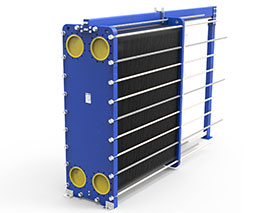

When changing a fluid’s thermal state, there has to be a temperature difference between the two mediums for heat transfer to take place, and the heat lost by the hot medium is equal to the amount of heat gained by the cold medium, except for losses to the surroundings.
To continually transfer heat between two mediums, heat exchangers are used. In a direct heat exchanger, both mediums are in direct contact with each other, while in the indirect heat exchanger, both mediums are separated by a wall through which heat is then transferred.
Outside of a heat exchanger, the predominant heat transfer is air, whilst internally it ranges from water, with or without additives, to natural and synthetic refrigerants, steam and even oils. All air-conditioning and refrigeration applications make use of heat exchangers and they extend to other industrial applications such as mining, power generation, military, transport, and agricultural cooling.
To start, when determining the optimal heat exchanger for an application, there are several factors to consider. “Some of the most common include flow rates, maximum pressure inside of the heat exchanger, pressure drop, temperature parameters, system pressures, liquid viscosity and concentration, system upset conditions (start-up/shut down), space availability, expansion plans, life cycle costs and maintenance requirements,” says Zaur Kutelya, business development manager for the Danfoss Heating Team. “Consideration also needs to be given to whether the application will endure continuous or cyclical conditions.”
The various heat exchanger options typically have different operating requirements, as well as preferable refrigerants per application. Each heat exchanger type is therefore designed to perform under particular application criteria.
Heat exchanger sizing is also a function of this application and affects every aspect of a heat exchanger coil. Other crucial considerations not already mentioned include tube sizing, material used, fin spacing and the overall construction methodology.
Further, avoidance of dissimilar metals in the unit removes risks such as galvanic corrosion in applications like marine vessels. Offering a multitude of alternatives allows manufacturers to provide the market with heat exchangers suitable for a wide range of conditions, satisfying all specifications.
Trends
Physical footprint has become a significant trend in recent years as available plant room space becomes smaller. Heat exchangers present themselves in various sizes to minimise the usage of floor space on sites.
Further, market design trends are focusing on the use of synthetic refrigerants, with significant attention being given to low charge systems. In the wider market, the trends have moved towards customers preferring full end-to-end solutions that minimise points of responsibility and localise all project design considerations. This approach means that each individual design decision and implementation is made with cognisance of its impact on the whole project, and therefore the best overall outcomes can be achieved while limiting expenses and errors.
A compact heat exchanger (plate type), depending on the technology and design parameters, is a set of thin heat transfer plates compressed together to form a plate-pack which forms the heat transfer area. Each compact technology has headers and followers which hold the plate packs together. The inner working of a plate heat exchanger is to transfer thermal energy between two fluids, without the fluids mixing.
Plate heat exchangers, now having a wider application use, are also generally smaller and so transportation and installation cost became lower, maintenance is easier, and they are higher in efficiency than the traditional shell and tube system.

© Technews Publishing (Pty) Ltd | All Rights Reserved